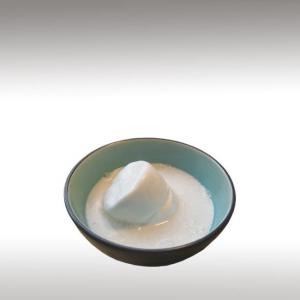
COCONUT MILK (COCOS NUCIFERA) - INGREDIENTS

BASE / GENERAL DATA
Information submited: March 7, 2015 Modified: May 30, 2018 By: OperaDreamhouse
Coconut milk is the liquid that comes from the grated meat of abrown Coconut. It should not be confused with Coconut Water. The colour and rich taste of Coconut Milk can be attributed to the high oil content.
The best Coconut Milk is made from the pressing of fresh, ripe Coconut meat.
The grating process itself can be carried out manually or with a more modern grating machine. Several grades of coconut milk exist: from thick at 20 - 22% fat to thin at 5 - 7%. Thick Milk is prepared by directly squeezing grated Coconut meat through cheesecloth. The squeezed Coconut meat is then soaked in water and squeezed further to produce thin Coconut milk.
Coconut Milk can be made at home by processing grated Coconut with hot water or milk, which extracts the oil and aromatic compounds. It has then a fat content of 17 - 24% depending on the fat level of the Coconut meat and the quantity of added water.
Good Coconut Milk has a clean, white color, rich creamy taste and is mildly sweet with the essence of Coconut. Once opened, cans of Coconut Milk must be refrigerated and are usually only good for a few days.
From Thailand to Hawaii to the West Indies, Coconut Milk has served to nourish millions worldwide as the creamy cornerstone of their delicious regional dishes.
Chemical structure:
Coconut, traditionally eaten across the South Pacific and in parts of Asia, is a powerhouse of nutrients. It’s high in saturated fatty acids and medium-chain triglycerides (MCT), which are both easily burned as fuel by the body.
Coconut is a potent source of lauric acid - a deeply nourishing fat which is otherwise only available in human breast milk.
Fresh, homemade Coconut Milk is also richer in Vitamins, food enzymes and nutrients than Coconut Milk from a tin.
The best Coconut Milk is made from the pressing of fresh, ripe Coconut meat.
The grating process itself can be carried out manually or with a more modern grating machine. Several grades of coconut milk exist: from thick at 20 - 22% fat to thin at 5 - 7%. Thick Milk is prepared by directly squeezing grated Coconut meat through cheesecloth. The squeezed Coconut meat is then soaked in water and squeezed further to produce thin Coconut milk.
Coconut Milk can be made at home by processing grated Coconut with hot water or milk, which extracts the oil and aromatic compounds. It has then a fat content of 17 - 24% depending on the fat level of the Coconut meat and the quantity of added water.
Good Coconut Milk has a clean, white color, rich creamy taste and is mildly sweet with the essence of Coconut. Once opened, cans of Coconut Milk must be refrigerated and are usually only good for a few days.
From Thailand to Hawaii to the West Indies, Coconut Milk has served to nourish millions worldwide as the creamy cornerstone of their delicious regional dishes.
Chemical structure:
Coconut, traditionally eaten across the South Pacific and in parts of Asia, is a powerhouse of nutrients. It’s high in saturated fatty acids and medium-chain triglycerides (MCT), which are both easily burned as fuel by the body.
Coconut is a potent source of lauric acid - a deeply nourishing fat which is otherwise only available in human breast milk.
Fresh, homemade Coconut Milk is also richer in Vitamins, food enzymes and nutrients than Coconut Milk from a tin.
Indeed, fresh Coconut Milk contains three times as much Vitamin C as canned Coconut Milk and is richer in thiamin, niacin, Vitamin B6, folate and pantothenic acid. Moreover, fresh raw Coconut Milk contains Vitamin E, a heat-sensitive, fat-soluble Vitamin that is otherwise absent in canned Coconut Milk.

SPIRITUAL PRACTISES DATA

MEDICINE / HEALTH DATA

BEAUTY / COSMETICS DATA
Information submited: March 7, 2015 Modified: May 30, 2018 By: OperaDreamhouse
Thick Milk is mainly used to make desserts as well as rich and dry sauces. Thin Coconut Milk is used for soups and general cooking.
How to make homemade Coconut Milk:
Ingredients:
2 brown coconuts
3 to 4 cups filtered water
Pierce the eyes of the Coconut with a sharp knife and drain Coconut water into a mixing bowl. Split the Coconuts by covering in a kitchen towel and smashing with a rolling pin or hammer.
With a sharp knife, pry the Coconut meat from its husk, then peel off any remaining brown bits of skin that adhere to the Coconut meat. Place the coconut flesh and Coconut water in a blender, adding three to four cups hot water blend until the Coconut and Water forms a smooth slurry.
Pour Coconut mixture through a butter muslin or nut milk bag into a mason jar or pitcher. Squeeze out as much liquid as possible, and transfer the Coconut Milk to the refrigerator.
How to make homemade Coconut Milk:
Ingredients:
2 brown coconuts
3 to 4 cups filtered water
Pierce the eyes of the Coconut with a sharp knife and drain Coconut water into a mixing bowl. Split the Coconuts by covering in a kitchen towel and smashing with a rolling pin or hammer.
With a sharp knife, pry the Coconut meat from its husk, then peel off any remaining brown bits of skin that adhere to the Coconut meat. Place the coconut flesh and Coconut water in a blender, adding three to four cups hot water blend until the Coconut and Water forms a smooth slurry.
Pour Coconut mixture through a butter muslin or nut milk bag into a mason jar or pitcher. Squeeze out as much liquid as possible, and transfer the Coconut Milk to the refrigerator.

FOOD / COOKING DATA
COMMENTS
No comments.
Newest mixtures containing Coconut Milk (Cocos Nucifera):

Coconut matcha latte
June 22, 2015

Home made Golden milk
May 12, 2015

Mixture for treat dry cough
March 8, 2015


